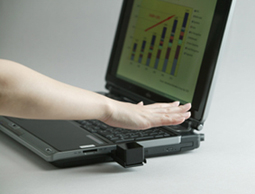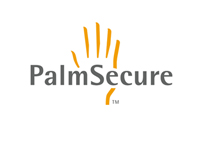Tokyo and Hannover, March 09, 2006
Fujitsu Limited and Fujitsu Laboratories Limited today announced the joint development and commercial introduction of a significantly more compact and higher performance model of their original award-winning contactless palm vein biometric authentication device. Targeting a major expansion of its biometric security systems business, Fujitsu will market the new device worldwide under the PalmSecure™ brand beginning today.
 Figure 1. New, compact model of Fujitsu PalmSecure™ device shown with laptop PC
Figure 1. New, compact model of Fujitsu PalmSecure™ device shown with laptop PCThe new PalmSecure™ model is being exhibited at CeBIT 2006, being held in Hannover, Germany from today through March 15.
Retaining the highly acclaimed features of its original palm vein authentication device - high authentication accuracy and application versatility, a biometric identifier internal to the body that makes forgery extremely difficult, hygienic and non-invasive authentication for greater user acceptance - the new Fujitsu PalmSecure™ model features dramatically faster authentication speed, a 35mm x 35mm sensor that is one-fourth the size of the previous model, an expanded operable temperature range, and lower cost. The smaller sensor footprint will provide greater flexibility and ease of implementation in current applications, including personal computers, ATMs, and room access systems, and greatly expand the range of potential new applications, in such areas as copiers and other office equipment, as well as electronic medical records and other solutions requiring highly secure authentication.

In conjunction with the new product launch, Fujitsu is enhancing its worldwide support for PalmSecure™. The company will provide a software development kit (available in English and Japanese) that includes sample applications and authentication rate evaluation tools, as well as a dedicated technical support website.
First commercially introduced in Japan in July 2004, Fujitsu's contactless palm vein authentication technology has been adopted by major Japanese financial institutions, universities, libraries, governmental organizations and private enterprises, with over 10,000 units deployed in a variety of applications. Moreover, since demonstrating the technology at last year's CeBIT in Hannover, and its subsequent commercial launch outside Japan a few months later in June 2005, the technology has generated considerable international interest, including active business discussions with several public and private sector organizations. Adding to this momentum, Fujitsu's palm vein authentication technology was honored with The Wall Street Journal 2005 Technology Innovation Award in the Security (Network) category and the 2006 International Consumer Electronics Show (CES), "Best of Innovations" Award for Biometrics.
Leveraging its new leading-edge product, enhanced technical support, global PalmSecure™ brand and worldwide network of group companies, Fujitsu aims to capture a significant share of the expanding global market for advanced biometric security systems.
Overview of New PalmSecure™ Product Offering
Availability
PalmSecure™ Sensor and PalmSecure™ Software Development Kit (SDK) will be available for delivery from the end of April 2006 in Japan, and from the end of June 2006 elsewhere.
Sales Network
Worldwide sales of the new PalmSecure™ model will be carried out principally by the following Fujitsu Group companies:
| Americas: |
Fujitsu Computer Products of America, Inc.
Fujitsu do Brasil Ltda. and others |
| EMEA: |
Fujitsu Europe Limited Group and others |
| Australia/New Zealand: |
Fujitsu Australia Limited |
Asia:
Japan
ASEAN Region
Korea
Taiwan |
Fujitsu Limited
Fujitsu Asia Pte Ltd. Group
Fujitsu Korea Ltd.
Fujitsu Taiwan Limited |
Sales Target
Fujitsu is targeting PalmSecure™-related sales of about 80 billion yen (approximately €600 million) over the next three years (including software, hardware and system integration revenue).
Key Improvements over Previous Model
More compact
Measuring just 35 x 35 x 27mm, the new sensor is one-quarter the size of the previous model, thereby expanding the range of potential applications.
Faster authentication
Authentication time has been dramatically reduced - to approximately half the time of the previous model for a straight one-to-one authentication. Fujitsu will continuously work to increase authentication speed.
Wider operable temperature range
The new model can be used in temperatures as high as 60°C, up from 50°C for the previous model, expanding the range of possible outdoor applications.
Improved usability with personal computers
The new model can be connected directly to the USB port of a notebook PC, or embedded into desktop PC keyboards.
Enhanced worldwide technical support*
A comprehensive software development kit, available in English and Japanese, provides sample applications and authentication rate evaluation tools. In addition, a dedicated PalmSecure™ support website offers technical data, enhanced services for related software, and timely Q&A support.
*From end of April 2006 in Japanese and end of June 2006 in English.
Additional Background on Fujitsu PalmSecure™
Advantages of Fujitsu's Palm Vein Authentication Technology
Difficult to forge
Because palm veins are beneath the body surface, they are extremely difficult to forge. Furthermore, compared to the pattern of veins in fingers or the back of the hand, palm vein patterns are more complex - again, increasing the difficulty of forgery - and more stable, as they are less affected by temperature and other external impacts. These factors, together with the system's high verification accuracy - a false acceptance rate of less than 0.00008% and false rejection rate of 0.01% - enable PalmSecure™ to provide highly secure and reliable personal identity verification.
High applicability
Unlike fingerprint-based authentication methods, for which registration and verification of biometric data cannot be successfully completed if the surface of the skin is impacted by abrasion or dryness, contactless palm vein authentication has negligible susceptibility to such external factors. In developing its palm vein authentication technology, Fujitsu collected data samples of 150,000 palm vein patterns from 75,000 individuals worldwide to verify authentication accuracy and applicability rate. In this process, there were no cases in which the data sample could not be registered and verified.
High user acceptance
In addition to requiring no direct contact with the scanner surface, the non-invasive scanning process is carried out in a simple and natural manner that is not awkward to the user. This alleviates potential psychological resistance due to concerns regarding hygiene or difficulty of use.
Sample Deployments in Japan
Banks
Account access at ATMs and teller windows; safe deposit box access; PC log-in
- Reference Customer: Bank of Tokyo-Mitsubishi UFJ
Universities
Student access to personal records such as academic transcripts; future plans to implement for class attendance monitoring, room access, book lending
- Reference Customer: Chiba Institute of Technology
Hospitals
Access control to record storage and server rooms
- Reference Customer: University of Tokyo Hospital
Condominiums
Front entrance access control
- Reference Customer: Meiwa Estate Company, Ltd.
Libraries
Cardless check-out
- Reference Customer: Naka City Library
Since July 2004 over 10,000 PalmSecure™ units have been deployed in Japan, including 6,000 units at major national and regional banks, 3,300 units as components embedded in other companies' devices, 1,000 units for PC log-in and 300 units for room access control at a variety of public and private sector organizations.
Awards
- The Wall Street Journal 2005 Technology Innovation Award for Security (Network)
- 2006 International Consumer Electronics Show (CES) Innovations Design and Engineering Awards "Best of Innovations" Award for Biometrics
- Awards from major Japanese newspapers (Nihon Keizai Shimbun, Nikkan Kougyou Shimbun) and The Japan Industrial Design Promotion Organization
For more information:
Fujitsu palm vein authentication technology: Overview, related press releases, research paper, case study http://www.fujitsu.com/global/about/rd/200506palm-vein.html
![]() Phone: +81-3-6252-2603
Phone: +81-3-6252-2603![]() E-mail: global-pv@ml.css.fujitsu.com
E-mail: global-pv@ml.css.fujitsu.com![]() E-mail: bio-inq@ml.css.fujitsu.com
E-mail: bio-inq@ml.css.fujitsu.com
